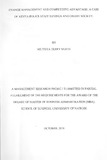| dc.description.abstract | Static competitive environment has been replaced by an increasingly dynamic uncertain environment, organizational flexibility is getting more and more attention, flexibility has already become the most important factors to acquire the future competitive advantage. While much has been written in the recent years about the concept of change management and competitive advantage, few organizations today truly have an effective, repeatable, project - level change management process and yet it is one of the most critical success factors for the organization.
Those companies able to cope successfully with change are more agile in both the strategic and the operational! tactical levels hence a significant competitive advantage. Change is associated with uncertainty and frequently involves complexity, confusion, disturbance and turbulence. This is often worse by the failure of management to articulate a clear vision of the proposed change and its intended outcome. The task of competitive analysis and strategic planning are central to building competitive advantage.
The dynamism in the money market in Kenya following the liberalization of the industry has threatened the very survival of the savings and credit cooperative societies in Kenya. The financial institutions providing long-term funds have since ventured into the short term money market. Mortgage and insurance firms are now providing shorter loans.
The market segments for shorter and long-term lending are no longer distinct. The industry previously served by cooperative societies has in the recent past been entered by other financial institutions and it is therefore imperative that a strategic change and competitive strategy is required to turnaround the
performance of Sacco's amidst the increasingly dynamic environment.
This study sought to establish how change was being managed at the Kenya Police Staff Savings and Credit Society, the relationship between change management and competitive advantage and the factors that influenced change management at the Sacco. The study was designed as a case study of the Kenya Police Staff savings and Credit Society and collection of data was through an in-depth personal tntervlew with some members of the central management committee and departmental beads who are charged with implementation of strategies at the society.
This being a qualitative research data was mostly qualitative in nature hence was analyzed by way of content analysis. The study findings showed that change at Kenya police Sacco bas been both planned and emergent. It also indicated that in most cases the board members proactively planned for change and others instances whereby new policies were introduced by the government in such instanCes, the Sacco bas been able to successfully adopt and manage change through change agents.
Formulation of change strategies is done by the board members and the top managers are tasked with the implementation process. This is as oPJlO'ed to a participatory approach of change implementation and management. Government regulations were found to be a big challenge in the implementation and
management of change hence it was necessary for the Sacco to ensure that there was adherence to these policies within the given timeframe.
Another barrier to effective change at the Sacco was found to be troublesome supervisors or departmental heads. Change management at the Sacco has also enabled the Sacco to compete successfully in the financial market but the link between change management and competitive advantage is not clearly defmed. The study concludes that the Sacco should be able to provide dedicated capacity by planning
and budgeting for it.
Management development must be integrated into the change process and stretch the duration of change to a maximum possible to assure timely responses to environmental challenges. The board members can facilitate and support the change process, communicate the change and encourage participation and involvement. | en_US |

